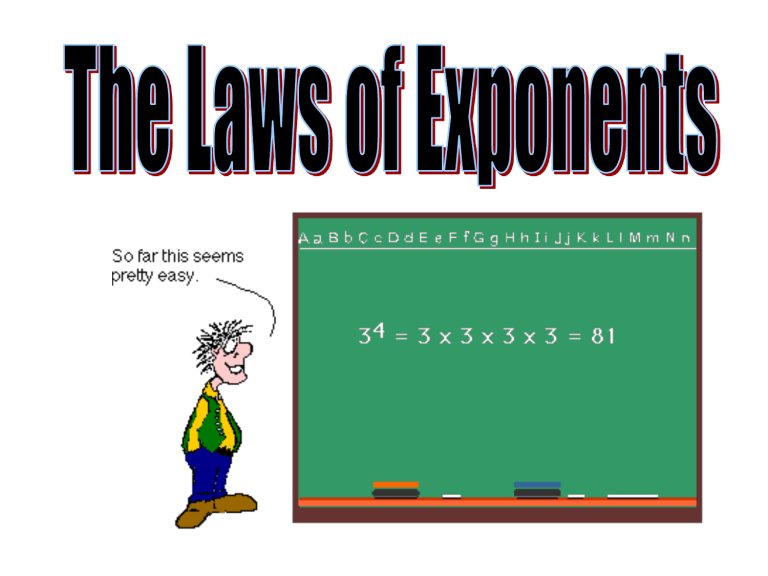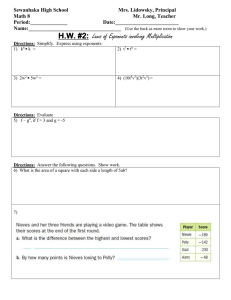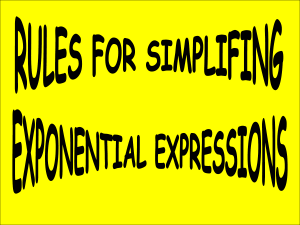
Exponents 5 exponent 3 Exponential Form base Example: 125 53 means that 53 is the exponential form of the number 125. 53 means the product of 3 factors of 5 = 5 x 5 x 5 The Laws Of Exponents The laws of exponents tell us how to simplify expressions involving exponents. There are 7 laws of exponents. Exponential form: raising a base to a power stands for repeated multiplication of the base times itself. x x x x x x x x n n times n factors of x Example: 5 5 5 5 3 Exponential form Standard form Questions What is a power? What is a base? What is exponential form? What is standard form? What are the laws of exponents? How many laws of exponents are there? Write in standard form. Write in exponential form. Questions Give an example of a power. Give an example of a base. Give an example of exponential form. Give an example of standard form. The Laws of Exponents: #1: Multiplying Bases: If you are multiplying bases with the same base, KEEP the BASE & ADD the EXPONENTS! x x x m So, I get it! When you multiply bases, you add the exponents! n mn 2 6 23 2 6 3 29 512 Try these: 1. 3 3 2 2 2. 52 54 3. a a 5 2 4. 2s 4s 2 7 5. (3) (3) 2 6. 3 s t s t 2 4 7 3 SOLUTIONS 2 2 2 4 a a a 5 2 a 1. 3 3 3 3 81 2 4 6 2 4 2. 5 5 5 5 2 3. 5 2 4. 2s 4s 2 4 s 2 7 5. (3) (3) (3) 2 6. 3 s t s t 2 4 7 3 s 7 27 23 8s (3) 243 27 43 t 9 5 s t 9 7 Questions What is the first law of exponents? When can I use it? When can I not use it? Give an example of where I use it. Give an example of where I can’t use it. Why does it work? Give an example. #2: Dividing Bases: When dividing bases with the same base, KEEP the BASE & SUBTRACT the EXPONENTS! m x m n mn x x x n x So, I get it! When you divide bases, you subtract the exponents! 6 2 6 2 4 2 2 2 2 16 Try these: 12 7. s 4 s 9 8. 3 5 3 12 8 9. s t 4 4 st 5 8 10. 36a b 4 5 4a b SOLUTIONS 12 7. 8. 9. 10. s 12 4 8 s s 4 s 9 3 9 5 4 3 3 81 5 3 12 8 s t 12 4 8 4 8 4 s t s t 4 4 st 5 8 36a b 5 4 85 3 36 4 a b 9 ab 4 5 4a b Questions What is the second law of exponents? When can I use it? When can I not use it? Give an example of where I use it. Give an example of where I can’t use it. Why does it work? Give an example. #3: Power of a Power: If you are raising a power to a power, you multiply the exponents! x n m So, when I take a Power to a power, I multiply the exponents x mn 32 (5 ) 5 3 2 5 6 Try these: 2 5 1. 3 2. a 3 4 SOLUTIONS 2 5 1. 3 2. a 3 4 10 3 a 12 Questions What is the third law of exponents? When can I use it? When can I not use it? Give an example of where I use it. Give an example of where I can’t use it. Why does it work? Give an example. #4: Product Rule of Exponents: Raising a product to a power means raising all of the factors to the power and then multiplying. xy So, the power of the product is the product of the powers. n x y n n (ab) a b 2 2 2 Try these: 3. 2a 2 2 3 5 3 2 4. 2 a b 5. (3a ) 2 2 2 4 3 6. s t SOLUTIONS 3. 2a 2 2 3 3 2 a 5 3 2 4. 2 a b 23 8a 22 52 32 4 10 6 10 6 2 a b 2 a b 16a b 5. (3a ) 3 a 2 2 2 2 4 3 6. s t 6 23 43 s t 22 s t 9a 6 12 4 Questions What is the fourth law of exponents? When can I use it? When can I not use it? Give an example of where I use it. Give an example of where I can’t use it. Why does it work? Give an example. #5: Quotient Rule of Exponents: Raising a quotient to a power means raising the numerator and denominator to the power. n x x n y y So, when I take a Power of a Quotient, I apply the exponent to all parts of the quotient. n 4 16 2 2 4 81 3 3 4 Try these: 5 s 7. t 2 3 8. 5 3 8 2 st 9. 4 rt 9 36a b 10. 4 5 4a b 5 8 2 SOLUTIONS 5 s 7. t 5 s 5 t 2 3 8. 5 34 3 9 2 3 8 2 4 2 2 8 st st s t 9. 4 2 r rt r 8 36a b 10 4 5 4a b 5 8 2 9ab3 2 2 32 9 a b 2 81a b 2 6 Questions What is the fifth law of exponents? When can I use it? When can I not use it? Give an example of where I use it. Give an example of where I can’t use it. Why does it work? Give an example. #6: Law of Negative Exponents: A base raised to a negative power is the reciprocal of the base to the positive power. So, when I have a negative exponent, I take the reciprocal and change the power to a positive. x m 1 m x 1 1 5 3 5 125 and 3 1 2 3 9 2 3 Try these: 2. 2 y y 4 3. a 2 7 5 1 4. s 4s 2 5. 3x y 3 4 1 2 7. x 2 39 8. 5 3 2 2 s t 9. 4 4 s t 2 5 36a 10. 4 5 4a b 2 2 SOLUTIONS 1 3. a 5 a 5 2 7 4. s 4s 4s 5 1 2 5. 3x y 3 4 4 3 x y 8 12 8 x 81y12 SOLUTIONS 1 1 x 2 4 7. x 4 x 9 2 1 3 4 2 8 8. 5 3 3 8 3 3 2 2 s t 2 2 2 4 4 s t 9. 4 4 s t s t 10 2 5 b 2 2 10 36a 9 a b 2 10. 4 5 81a 4 a b 2 2 Questions What is the sixth law of exponents? When can I use it? When can I not use it? Give an example of where I use it. Give an example of where I can’t use it. Why does it work? Give an example. #7: Zero as an exponent: Anything to the zero power is 1. x 1 0 So whenever I raise anything to the zero power it is always 1! 50 1 and a0 1 and (5 a ) 0 1 Try these: 1. 2a b 6. s t 2 2 4 0 0 SOLUTIONS 0 1. 2a b 1 2 2 4 0 6. s t 1 Questions What is the seventh law of exponents? When can I use it? When can I not use it? Give an example of where I use it. Give an example of where I can’t use it. Why does it work? Give an example.

